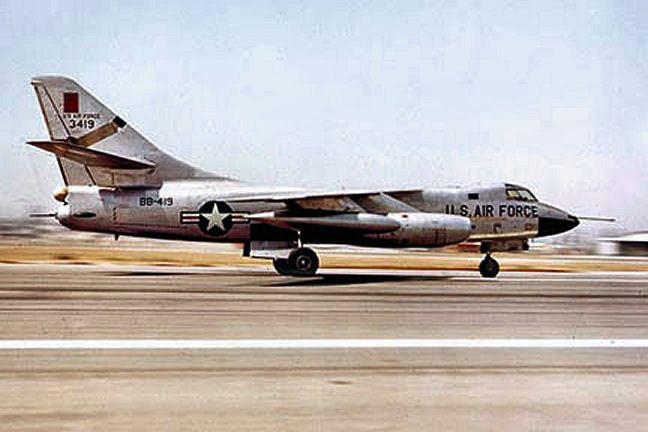Active 1940–45, 1965–1966 Motto(s) Guard With Power | Country United States | |
 | ||
Branch United States Air Force | ||
The 25th Tactical Reconnaissance Wing (TRW) is an inactive United States Air Force wing. Its last duty assignment was at Chambley-Bussieres Air Base, France.
Contents
History
The wing's lineage and honors can be traced not just through its own history, but through the history of two World War II organizations, the 25th Bombardment Group (Medium) and the 25th Bombardment Group, Reconnaissance.
25th Bombardment Group (Medium)
The air echelon consisted of:
25th Bombardment Group, Reconnaissance
The 25th Bombardment Group (Reconnaissance) was formed at RAF Cheddington, England as the 8 Reconnaissance Group (Special)(Provisional) on 22 March, then changed to 802d Reconnaissance Group (Special)(Provisional) on 30 March 1944, and transferred to Watton on 12 April 1944. On 9 August 1944, the 802 RG(P) was redesignated as the 25th BG(R). Assigned squadrons were:
Cold War
The 25th Tactical Reconnaissance Wing was activated on 1 July 1965 at Chambley-Bussieres Air Base, France as part of USAFE. Upon activation, the wing absorbed the 19th Tactical Reconnaissance Squadron and 42d Electronic Countermeasures Squadron. The squadrons were transferred from Toul-Rosieres AB, where they operated as a detachment of the 10th Tactical Reconnaissance Wing, based at RAF Alconbury, UK.
The 25th flew variants of the B-66 "Destroyers" on photo reconnaissance and electronic warfare missions. The 42d flew RB-66Cs that had a seven-man crew. Its primary mission was electronic reconnaissance, commonly called "Ferret" operations; the ECM operators were known as "Ravens" The 19th flew RB-66Bs with a three-man crew and the mission of day and night photography. Both squadrons flew its aircraft with a natural aluminum finish, the differences being that the 19th carried a red band on the engine nacelle; the 42d carrying a blue band. The 19th operated 20 aircraft; the 42d operated 12.
Having been reassigned from other wings, both the 19th and 42d were familiar with their missions and aircraft. But the wing was kept busy training newly assigned support personnel to operate and maintain the base. One major drawback of the B-66 was pilot training. It was always a problem because the B-66 was a single pilot aircraft and dual checkout was impossible. A large B-66 analog electronic flight-crew simulator built by Curtis Wright was very useful for checkout of the flight deck crew: pilot, navigator/camera operator, and gunner. Training the RB-66C ECM operators was more difficult since the USAF had not purchased a comparable electronic warfare simulator for their ground training. Thorough training in the RB-66B camera system was critical to accomplish the mission. The system was complex, involving three cameras, camera compartment temperature and pressure controls, flash bomb and camera shutter intervalometers, a universal camera control unit, a stabilized camera mount, and flash bomb bay operation. Later electronic warfare jamming transmitters were added to the RB-66s, increasing the mission workload.
Day and night photographic training was hindered by the 1965 ruling made by the French government that prohibited aerial photography over their country. This forced photo missions to West Germany and Great Britain. Night photography was limited since suitable ranges for dropping the M-120, and M-122 photo flash bombs were not available after the close of the USAFE Moroccan air bases.
The escalation of the conflict in Southeast Asia prompted the establishment of Detachment 1 of the 42d Electronic Countermeasures Squadron at Takhli RTAFB during February 1966. 6 of its B-66's were deployed on Temporary Duty to Thailand from Chambley to this new theater of operations.
On 7 March 1966, French President Charles De Gaulle announced that France would withdraw from NATO's integrated military structure. The United States was informed that it must remove its military forces from France by 1 April 1967. As a result of this, on 22 August 1966 the 42d Electronic Countermeasures Squadron was inactivated at Chambley and the majority of the aircrews, including sixteen EWOs and ten RB-66Cs were sent to the 432d Tactical Reconnaissance Wing based at Takhli RTAFB, Thailand. A few of the EB-66 aircraft were flown to Douglas Aircraft's Tulsa, Oklahoma plant for additional ECM equipment and camouflage painting before going to Southeast Asia.
About 1 August 1966 the 19th Tactical Reconnaissance Squadron (Photo) was ordered to move its twenty RB-66Bs to Shaw Air Force Base, South Carolina, and was assigned to the 363d Tactical Reconnaissance Wing. It flew its RB-66Bs from Chambley to Moron AB, Spain, then after refueling, it flew nonstop to Shaw with the aid of three air-to-air refuelings. Officially the 19th TRS was to become another of USAFE's dual-based units (units based in the U.S. but available for operations in Europe). Actually the squadron and its RB-66Bs were needed to train aircrews for the expanding combat operations over the skies of Southeast Asia during the Vietnam War.
On 15 October 1966 USAFE inactivated the 25th Tactical Reconnaissance Wing at Chambley as part of the USAF pullout from France.
Lineage
25th Bombardment Group (Medium)
25th Tactical Reconnaissance Group
25th Tactical Reconnaissance Wing
